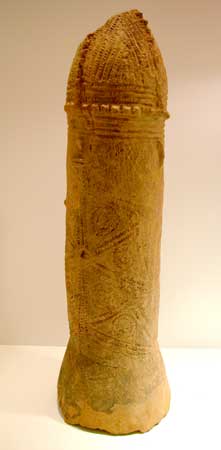Bura Terracotta Phallic Vessel with a Face, 3rd Century CE - 11th Century CE
Terracotta
6.5 x 20
X.0699 (LSO)
Further images
This outstanding ceramic vessel was made by one of the most inscrutable groups in pre-colonial Africa: the Bura. Like many Bura pieces, it is phallomorphic (phallus-shaped). The base is slightly...
This outstanding ceramic vessel was made by one of the most inscrutable groups in pre-colonial Africa: the Bura. Like many Bura pieces, it is phallomorphic (phallus-shaped). The base is slightly flared, narrowing to a straight-sided shaft with a tapered apex demarcated from the main body of the shaft by a horizontal line of beading. The anatomical detailing is continued by a line of beading that represents the phrenulum and urethra. The shaft is decorated with outstanding incised and stippled designs based around a geometric wheel/floral pattern. There are three incised bands beneath the beading. The shaft is further decorated with a reductivist face in low relief, including small circular eyes, a linear nose and a simplified mouth. The rear of the piece is plain; this perhaps implies that it was designed to be viewed from the front, and was maybe an adorational piece. It is unlikely to have had any more utilitarian purpose.
The Bura are a true paradox: almost nothing is known of this shadowy Nigerian/Malian group. They appear to have originated in the first half of the first millennium AD, although the only archaeologically-excavated site (Nyamey) dates between the 14th and 16th centuries. They are contemporary with – and probably related to – the Djenne Kingdom, the Koma, the Teneku and a satellite culture known as the Inland Niger Delta. Insofar as can be ascertained, the Bura share certain characteristics with these groups; for our purposes, these include extensive ceramic and stone sculptural traditions. The Bura appear to have been sedentary agriculturists who buried their dead in tall, conical urns, often surmounted by small figures. Their utilitarian vessels are usually plain, while other “containers” – the function of which is not understood – are often decorated with incised and stamped patterns. Their best-known art form is radically reductivist anthropomorphic stone statues, with heads rendered as squares, triangles and ovals, with the body suggested by a columnar, monolithic shape beneath. Phallic objects are also known; some phallomorphic objects may have been staffs, perhaps regalia pertaining to leaders of Bura groups. Ceramic heads are usually more complex than their stone counterparts, with incised decoration and variable treatment of facial proportions and features. There are a few very rare equestrian figures: these bear some resemblance to Djenne pieces. Almost no intact human (or equestrian) figures are known.
The role of these figures is almost totally obscure. Equestrian figures probably represent high status individuals, and the very few full-body representations of humans may be portraits or ancestor figures. Intuitively – as with so many other groups both inside and beyond Africa – figures with exaggerated sexual characteristics would tend to be associated with fertility and fecundity, as would any artefact modelled in the shape of pudenda (although the sceptre-like qualities of some such pieces should be noted – see above). Even ceramic vessels are shaped in this manner. Many of these pieces are believed to have been found in burials, perhaps implying an importance that would have been linked to social standing and status. The potentially adorational function of this piece is an unusual finding.
Whatever its purpose or function, however, it cannot fail to impress. This is a striking and attractive piece of ancient art from one of Africa’s great lost civilisations.
The Bura are a true paradox: almost nothing is known of this shadowy Nigerian/Malian group. They appear to have originated in the first half of the first millennium AD, although the only archaeologically-excavated site (Nyamey) dates between the 14th and 16th centuries. They are contemporary with – and probably related to – the Djenne Kingdom, the Koma, the Teneku and a satellite culture known as the Inland Niger Delta. Insofar as can be ascertained, the Bura share certain characteristics with these groups; for our purposes, these include extensive ceramic and stone sculptural traditions. The Bura appear to have been sedentary agriculturists who buried their dead in tall, conical urns, often surmounted by small figures. Their utilitarian vessels are usually plain, while other “containers” – the function of which is not understood – are often decorated with incised and stamped patterns. Their best-known art form is radically reductivist anthropomorphic stone statues, with heads rendered as squares, triangles and ovals, with the body suggested by a columnar, monolithic shape beneath. Phallic objects are also known; some phallomorphic objects may have been staffs, perhaps regalia pertaining to leaders of Bura groups. Ceramic heads are usually more complex than their stone counterparts, with incised decoration and variable treatment of facial proportions and features. There are a few very rare equestrian figures: these bear some resemblance to Djenne pieces. Almost no intact human (or equestrian) figures are known.
The role of these figures is almost totally obscure. Equestrian figures probably represent high status individuals, and the very few full-body representations of humans may be portraits or ancestor figures. Intuitively – as with so many other groups both inside and beyond Africa – figures with exaggerated sexual characteristics would tend to be associated with fertility and fecundity, as would any artefact modelled in the shape of pudenda (although the sceptre-like qualities of some such pieces should be noted – see above). Even ceramic vessels are shaped in this manner. Many of these pieces are believed to have been found in burials, perhaps implying an importance that would have been linked to social standing and status. The potentially adorational function of this piece is an unusual finding.
Whatever its purpose or function, however, it cannot fail to impress. This is a striking and attractive piece of ancient art from one of Africa’s great lost civilisations.









